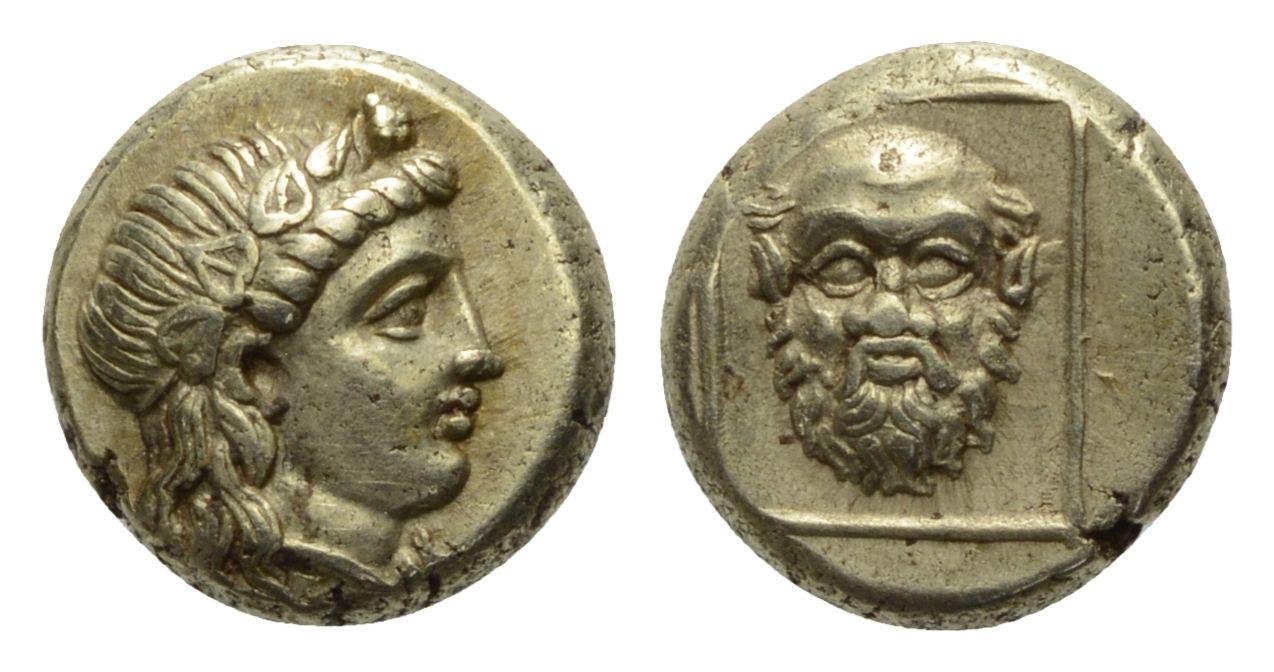AC 215 - Mytilene, electrum, hekte, 377-326 BC
From SILVER
377 BCE - 326 BCE Electrum 102,877 kg
Description
| ObverseInscription or printing placed on the obverse.: | Head of Dionysus with ivy wreath right. |
| ReverseInscription or printing placed on the reverse.: | Head of a bearded Silens from the front, the whole in line square. |
Mint and issuing power
| MintIdentifies the place of manufacture or issue of a numismatic object.: | Mytilene | Ancient regionAncient region.: | Aeolis (islands) | Modern countryModern country: Greece | AuthorityIdentifies the issuing power. The authority can be "pretended" when the name or the portrait of X is on the coin but he/she was not the issuing power. It can also be "uncertain" when there is no mention of X on the coin but he/she was the issuing power according to the historical sources: |
Chronology
| FromIdentifies the initial date in a range assigned in a numismatic context. | 377 BCE | toIdentifies the final date in a range assigned in a numismatic context.. | 326 BCE | PeriodTime period of the numismatic object.: Classical 480-323 BC |
Physical description
| MetalThe physical material (usually metal) from which an object is made.: | Electrum http://nomisma.org/id/el | Median weightMedian of the weights of numismatic objects (in grams). in grams | 2.55 | DenominationTerm indicating the value of a numismatic object. Examples: tetradrachm, chalkous, denarius.: | hekte |
StandardStandard.: |
Image

AC215 Mytilene.jpeg [1]
References
Obverse dies distribution
| FrequencyFrequency of specimen in distribution. ᵖ | Number of obversesNumber of obverse dies. ᵖ (o) | % (o) | Number of coinsNumber of coins. (n) | % (n) | Die nameName(s) of the die(s). |
| 1 | 41 | 23.16 | 41 | 5.26 | 81b, 82a, 83a, 83b, 83i, 84a, 85c87a, 88a2, 89c, 90b, 90f, 90i, 90k, 90o, 90p, 90q, 91g, 92d, 94b, 94e, 95e, 95h, 95i, 95k, 95l, 95r, 95s, 95t, 95x, 96i, 97a, 99d, 99f, 100Co, 101a, 102a103a, 105b, 105c, 105h |
| 2 | 37 | 20.9 | 74 | 9.5 | 83f, 83h, 83k, 86a, 86f, 87b, 87d, 88b, 88h, 90a, 90d, 92f, 94c, 95a, 95b, 95d, 95f, 95m, 95n, 95o, 95q, 95w, 95y, 96a, 96g, 98b, 99e, 99i, 99k, 100Ae, 100Bh, 101b, 101c, 103b, 103c, 104a, 105d |
| 3 | 17 | 9.6 | 51 | 6.55 | 3 81a, 81c, 83e, 83l, 85d, 90c, 91f, 95g, 95p, 95u, 96e, 98a, 98c, 99a, 100Cn, 104c, 105f |
| 4 | 22 | 12.43 | 88 | 11.3 | 83c, 86a, 86b, 87e, 88c, 88d, 89b, 90e, 90h, 90n, 92c, 94a, 95c, 95v, 96b, 96d, 99c, 99g, 100Ad, 100Bi, 104d, 105e |
| 5 | 10 | 5.65 | 50 | 6.42 | 81d, 89a, 90m, 92b, 92e, 96c, 96h, 100Ab, 100Af, 100Bk |
| 6 | 16 | 9.04 | 96 | 12.32 | 80a, 83g, 85a, 86c, 86h, 88a1, 90g, 90l, 91h, 92a, 96f, 99b, 104g, 104h, 105a, 105g |
| 7 | 9 | 5.08 | 63 | 8.09 | 81f, 86e, 88e, 93a, 96k, 100A, 104e, 104i, 105i |
| 8 | 7 | 3.95 | 56 | 7.19 | 88f, 88g, 91e, 99h, 100Ac, 100Bl, 104b |
| 9 | 7 | 3.95 | 63 | 8.09 | 81e, 81g, 85b, 91d, 94d, 101d |
| 10 | 1 | 0.56 | 10 | 1.28 | 86g |
| 11 | 2 | 1.13 | 22 | 2.82 | 83d, 100Cp |
| 18 | 2 | 1.13 | 36 | 4.62 | 91a, 99l |
| 19 | 2 | 1.13 | 38 | 4.88 | 104f, 104k |
| 21 | 1 | 0.56 | 21 | 2.7 | 95z |
| 22 | 1 | 0.56 | 22 | 2.82 | 100Ag |
| 24 | 2 | 1.13 | 48 | 6.16 | 91b, 100Bn |
| Total | 177 of 177 | 99.96 | 779 of 779 | 100 |
Reverse dies distribution
no distribution is available
Quantification
| Number of obversesNumber of obverse dies. ᵖ (o) | 177 | Number of singletons (o1)The number of singleton coins. ᵖ | 41 |
| Number of reverse diesNumber of reverse dies. (r) | NC"NC" is not a number. | Number of coinsNumber of coins. (n) | 779 |
| Coins per obverse dieNumber of coins per obverse die. (n/o) | 4.4 | Coins per reverse dieNumber of coins per reverse die. (n/r) | |
| Reverse per obverse ratioRatio of obverse dies divided by reverse dies. (r/o) | Percentage of singletons (o1)number of coins (n) divided by the number of singletons (o1) ᵖ | 23.16 % | |
| Original number of dies (O) (Carter 1983 formula)The estimation of the number of coins according to Carter 1983 ᵖ | 201.72 | Coins struck if 20,000 as average productivity per dieCoins made if the average productivity for obverses (according to Carter) is 20,000. ᵖ | 4,034,400 |
| Original number of dies (O) (Esty 2011 formula)The estimation of the number of coins according to the singleton formula in Esty 2011 ᵖ (O) | 229.04 | Survival rate if 20,000 as average productivity per dieSurvival rate if average productivity is 20,000. ᵖ | 0.00019 |
| Coverage (o = % of O) (Esty 1984 formula)Esty 1984 - coverage (% of O) ᵖ (o = % of O) | 94.74% | Die productivity if survival rate 1/2,000Average productivity if survival rate is 1/2,000. ᵖ | 7,723.58 |
| Weight of silver (in kg) if 20,000 coins per die (O = Carter formula)Carter 1983 * Median weight * 20000 (*10 if gold or electrum) ᵖ | 102,877 kg <br /> 102,877 kg | Die productivity if survival rate 1/5,000Average productivity if survival rate is 1/5,000. ᵖ | 19,308.94 |
Remarks